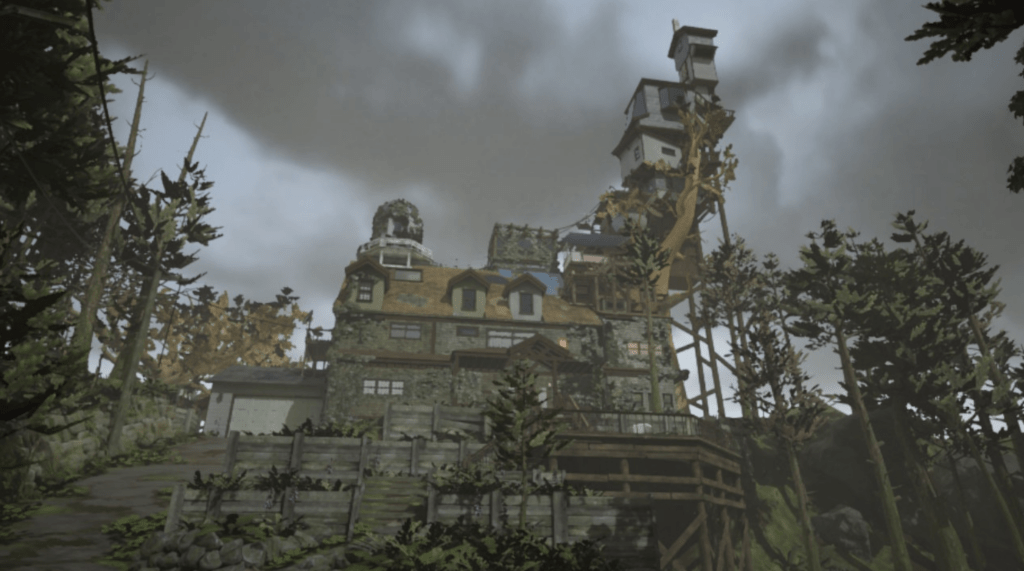Critical Play: What Remains of Edith Finch
The idea of What Remains of Edith Finch was developed by Ian Dallas for Indie game studio Giant Sparrow. It can be played on playstation, xbox, ios, mac, and pretty much any other digital platform you can think of. The target audience is probably people ages 16-18 and older, as it deals with concepts like unexpected death and trauma and suicide.
The walking in this game tells a beautiful story about the beautiful mysteries of death. I had no idea what I was getting into with this game, but I am certain now that I am going to finish it. It is open ended although each story has an end. It embodies Discovery, Narrative, and Sensation as types of fun that drives the player to immerse themselves in this playing experience.
The first type of fun that helps tell this story is Discovery. Your POV starts as the title character, Edith, who has returned to her family home to try and unlock the mysteries of why they are all dead. The mechanic of walking and also looking around to change direction is the main driver of these discoveries. It is slightly difficult to learn to walk in this game, which creates the dynamic that the player has to make 360 degree turns if they get stuck in a corner or too close to a wall. The next object that the game wants the player to interact with is always highlighted with a barely noticeable white dot, which also helps with this “explore every nook and cranny” dynamic. The aesthetic of every turn is generally sunset like and colored in sepia tones, which creates a beautiful, but also looming and ominous tone that helps the theme of the “beautiful death” of the story. Because of this slightly spooky, darker hued aesthetic, the player constantly feels a little uneasy as they explore the Finch house, just like the uneasy and uncertain feelings people have around death. However, the house itself is also very homey, with thousands of niche trinkets everywhere and plush furniture and fully lit up and colorful rooms, which enhances the beauty the user is also supposed to appreciate. It is a complicated juxtaposition that keeps the “discoverer” hesitant but also comfortable enough to search for more.
Another key type of fun that contributes to the story is the Narrative. The main narrative is Edith Finch’s, for which we are trying to find clues by exploring short flashback narratives of her family members. These short stories are a big driver of the game itself. Many of the stories have hints about where the player should go next in the house once the short narrative is over. This creates the dynamic of revisiting old places in the house the player already visited before, but with new perspectives and ideas of what tools they should approach. These short stories all seem disconnected to me, though, with their only two similarities being that they are beautiful in aesthetic but all end in a death. One of the main things that differentiates the stories but also keeps the game play fun and interesting is that they all have different “walking” mechanics. In one story, you become a bunch of different animals that do different things like jump, swim, and crawl. In another, you are navigating through a comic book and must sneak around to get to each panel. And in another, you simply are swinging over a cliff high and higher until you find out that you must loop around the tree branch you swing from to fling yourself into a beautiful suicide. None of these new mechanics have instructions, but none of them are particularly frustrating or hard to figure out. Figuring it out creates the magic of each family member, and always having to die in the end is a strangely comforting goal.
Lastly there is the Sensation of the game. The mechanics of manipulating objects requires the player to physically turn keys to open locks, flip through pages of books, and push open hidden doors. The developers could have just had all of this done automatically when the player taps the screen, but instead they force the player to really embody the character that they currently are. There are also many different types of walking in this game that are very sensory oriented. When you are simply walking, you can hear your footsteps change with the different grounds you walk on. If you are a shark and you are swimming, you can feel the pressure of the water making it slightly harder to swim forward. When you are swinging on your death swing, you can hear the ocean waves below you and the beautiful sunset in front of you seems to call you to jump into it. All of these sensory aspects help immerse the player in the game, and make the experience feel really magical and wonderful. The end of each story does not even really feel like death because of these things- it just feels like the end of a beautiful and tragic chapter of a book (which I guess it technically is).
All in all, What Remains of Edith Finch is a wonderful game that, through its walking aspect, tells a beautiful story about death and why it can be a beautiful mystery. Like I said, I am not done yet but am planning on continuing playing. I do not often play games with the types of fun I listed above, but I learned that I really like discovery/ walking simulator games!





